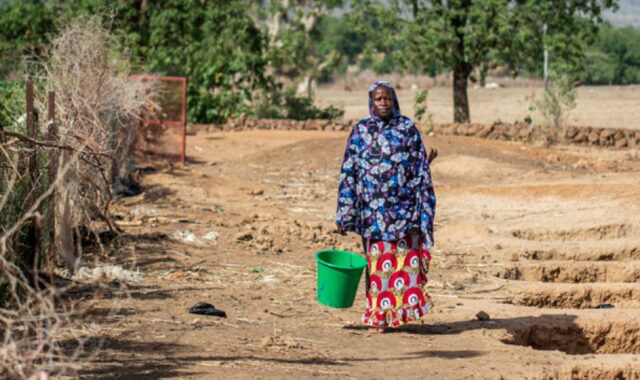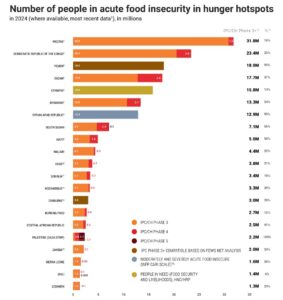
…Between June and August 2024, 31.8 million people in Nigeria (16 percent of the population analysed) are projected to face Crisis or worse
WED JUNE 05 2024-theGBJournal|Nigeria have joined Burkina Faso, Ethiopia, Malawi, Somalia and Zimbabwe in the list of hunger hotspots, where acute food insecurity is likely to deteriorate further during the outlook period, a new United Nations early warning report has revealed today.
Other countries included in the list since the previous edition of the Hunger Hotspots report in October 2023, are Central African Republic, Lebanon, Mozambique, Myanmar, Sierra Leone and Zambia.
The report, ‘Hunger Hotspots- FAO-WFP early warnings on acute food insecurity’, says the number of people in acute food insecurity in Nigeria has risen by 16% to 31.8 million.
Key drivers of acute food insecurity include macroeconomic challenges, high food prices, insecurity.
The report notes that food insecurity will likely remain highly concerning, due to a multidimensional crisis driven by weakening macroeconomic conditions, heightened insecurity and subdued agricultural production.
In March 2024, the inflation rate exceeded 33 percent year-on-year, eroding the frail purchasing power of households in a country where 38 percent of Nigerians live below the poverty line.314
On top of that, the naira has been strongly fluctuating, registering a yearly
depreciation of 60 percent in February 2024. Due to below average cereal production in 2023 and high transport costs, prices of major staples such as rice and maize were 105 and 241 percent higher, respectively, on a yearly basis, in February 2024.
During the outlook, import restrictions amid abating foreign reserves, increasing farming costs, and high levels of conflict in the North East, North West and parts of the North Central zones will likely impact the 2024 agricultural season.
This will cause reduced yields and elicit further inflationary pressures.
According to the report, the security situation is likely to continue to deteriorate, exacerbating population displacement. This is a particular concern
for the northern states, which have already seen an uptick in insurgency, banditry and kidnapping in the first quarter of 2024.
The latter increased 44 percent in the first quarter of 2024 compared
to the same period in 2023.320 Insecurity has been disrupting agricultural livelihoods and affecting the functionality of markets.
Insecurity results in high humanitarian access constraints, particularly in the northeast, restricting the delivery of assistance to government-controlled towns and their immediate surroundings.
Between June and August 2024, 31.8 million people in Nigeria (16 percent of the population analysed) are projected to face Crisis or worse (CH Phase 3 or above) levels of acute food insecurity, with nearly 1 million people projected to be in Emergency (CH Phase 4).
This represents a 3 percentage points increase in the number of acutely food insecure people compared to the same time in the previous year.
Acute malnutrition levels remain high, above 10 percent, in the northern states (Borno, Yobe, Sokota, Katsina and Zamfara), with 4.4 million children and 585 000 pregnant and breastfeeding women projected to be acutely malnourished in 2024.

RECOMMENDATIONS
Anticipatory actions
– Preposition and promptly distribute agricultural inputs or offer unconditional cash transfers to displaced
populations and host communities in anticipation of and response to conflict outbreaks.
– Provide an anticipatory cash advance to people likely to be most impacted by floods.
– In addition, distribute flood-proof storage equipment to pre-identified people.
– Distribute double rations in flood-prone areas in case access to populations is affected.
Emergency response
To fully implement the HRP, humanitarian partners require US$ 1.3 billion to assist 6 million people prioritized for humanitarian assistance.
– Enhance livelihood assistance for farmers in anticipation of the upcoming agricultural season, by supplying seeds and tools.
– Improve the timeliness, coordination and integration of food security analysis and response efforts to boost local capacity, and foster collaboration with other sectors and interventions.
– Scale up the production and distribution of locally produced supplementary food for improved nutrition, such as Tom Brown.
– Sustain humanitarian assistance to conflict-affected areas in the northeast, northwest and northcentral
parts of the country, allowing for the lean season scale-up.
– Provide conditional cash-based transfers to conflict-affected populations, using the rapid response registry and the national social register where appropriate to establish a predictive, shock responsive, social protection mechanism.
– Scale up acute malnutrition prevention and treatment programmes in the northeast and northwest, in coordination with government, nutrition, food security, WASH and health partners.
Other actions
-Create a digital social registry for populations in flood-prone areas, to enable timely response and better targeting.
The report also spotlights the urgent need of assistance to prevent famine in Gaza and the Sudan, and further deterioration in the devastating hunger crises in Haiti, Mali, and South Sudan.
It also warns of the lingering impact of El Niño and the looming threat of La Niña that risks bringing further climate extremes that could upend lives and livelihoods.
This edition of the report warns that La Niña conditions are expected to prevail between August 2024 and February 2025, significantly influencing rainfall distribution and temperatures.
It says the shift in climate could have major implications for several hotspots, including risk of floods in parts of South Sudan, Somalia, Ethiopia, Haiti, Chad, Mali and Nigeria, as well as the Sudan.
Meanwhile, the Caribbean is bracing for an extremely active Atlantic hurricane season.
The report warns that due to the uncertainty of current forecasts, continuous monitoring will be vital.
“The daunting prospects highlighted in this report should serve as a wake-up call to all of us.
We need to spearhead the shift from responding to crises after they occur to more proactive anticipatory approaches, prevention and resilience building to help vulnerable communities cope with upcoming shocks.
Acting ahead of crises can save lives, reduce food shortages and protect livelihoods at a much lower cost than a not timely humanitarian response,” FAO Director-General QU Dongyu said.
“Once a famine is declared, it is too late – many people will have already starved to death. In Somalia in 2011, half of the quarter of a million people who died of hunger perished before famine was officially declared. The world failed to heed the warnings at the time and the repercussions were catastrophic.
We must learn the lesson and act now to stop these hotspots from igniting a firestorm of hunger,” said Cindy McCain, WFP Executive Director.
“We have proven solutions to stop these crises in their tracks, but we need the resources and the political will to implement them at scale before more lives are lost.”
X-@theGBJournal|Facebook-the Government and Business Journal|email:gbj@govbusinessjournal.com|govandbusinessj@gmail.com









